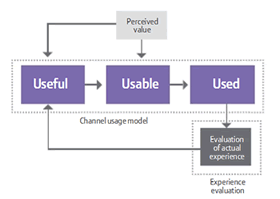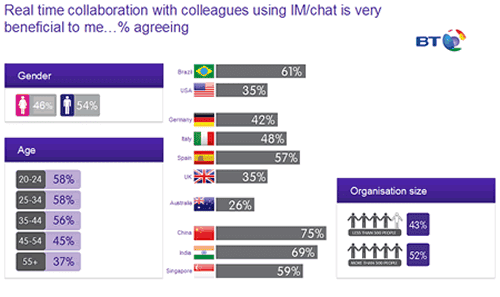
The main de facto area of social business today is social collaboration, sometimes as an enterprise-wide initiative within an enterprise collaboration and unfified communications framework and sometimes in a situational context or as part of a social business pilot.
Social collaboration involves several people and requires you to work together from the very start. Everyone is your customer and it’s crucial to understand what all stakeholders (internal and external) want YOU to know. In a collaboration context, this is translated in a focus on, among others, usefulness and usability. Or as customer experience expert Nicola Millard calls them: useful, usable and used. That’s a first lesson.
Agility and content are not a fad
Forget about the real-time economy for a moment. Just think about the speed of doing business. As a very exhaustive report from BT Global Services, one of our customers, clearly indicates slow decision making and communication is a cause of what the research calls ‘The Collaboration Paradox’. Simply said, being transparent, flexible and agile is not theory. It’s at the very center of success. The processes of decision-making need to be faster. More importantly, they need to change. This is what makes social collaboration and the technologies enabling it so interesting: the possibility to participate in vast operations as if you still were that small business with rapid decision cycles.
As Nicola Millard writes in her paper ‘The networked watercooler: virtualising collaboration’ (get it via Scribd), one of the big strengths of social collaboration platforms is that they combine communication with content. Access to content, knowledge and information is also a crucial part of the possibility to speed up processes and keep up with rapidly changing customer and market realities. Remember Digital Darwinism. The collaboration paradox survey found 56% of global execs is faced with slow decision making by managers and colleagues and 36% simply does not have information at hand. At the same time, however, real-time collaboration is seen as very beneficial.

Everyone is involved
Another lesson to remember regarding social business is one that is well-known by many but ask yourself how ready you are? Everyone is involved. It’s a logical consequence of what I just wrote but it goes further. Social business is business. However, a social enterprise requires a very strong integration of IT and all different business functions. It’s clear social and digital technologies play a crucial role here.
More importantly, however, the role of IT is changing and more closely related with business objectives than ever before. In social business projects, no department is left out when striving to achieve that common goal, which in the end is about optimizing the business and the customer’s experience. Moreover, to become a social enterprise you need a combination of lateral, vertical and diagonal approaches. The team is real and virtual at the same time. Marketers need to learn this lesson too.
The buy-in of C-level execs is important and so you need to be very clear about everything you do. But, at least as importantly, you want to engage your internal customers, the many voices, ears and faces that constitute your brand, business and stories AND that make collaboration succeed. Saying that participation is a cornerstone of collaboration is no fluffy theory. It’s a harsh reality when you want to succeed.
A staged approach matters
When I started working on social business projects, several criteria played a role. Some of them change depending on the customers and others remain. You could consider them extra ‘general’ conditions for success:
- One or more internal champions.
- Clear goals and ability to make the case (regardless of stakeholders). Let’s say: a strategy.
- Buy-in and people.
- A collaboration mindset.
- Knowledge and content.
- An ability/will to truly listen.
One that was crucial very often, was a calculated and staged approach. Many businesses just want to ‘do’ social. However, every step you take needs to make sense and be properly calculated and tested. In this way, social business is a lot like marketing optimization and that shouldn’t even be a surprise: staged and incremental simply works best if you don’t want to lose the overview and build a solid social house. Note: even if you work in a staged way, having a clear overall view and vision for the future is a must.
Trust and initiative are key
Finally, trust, trustability and the freedom to take initiative are essential. Trust, initiative and many of the mentioned real-life lessons I have the opportunity to experience every day, indeed often come back and confidence is certainly part of it.
More social business and social collaboration success factors in the 9 Cs of people-centric collaboration.
Stay tuned for more and in the meantime: start collaborating and integrating. The need to optimize efficiency and focus on human needs and smooth processes has never been higher. You know what I am talking about…

